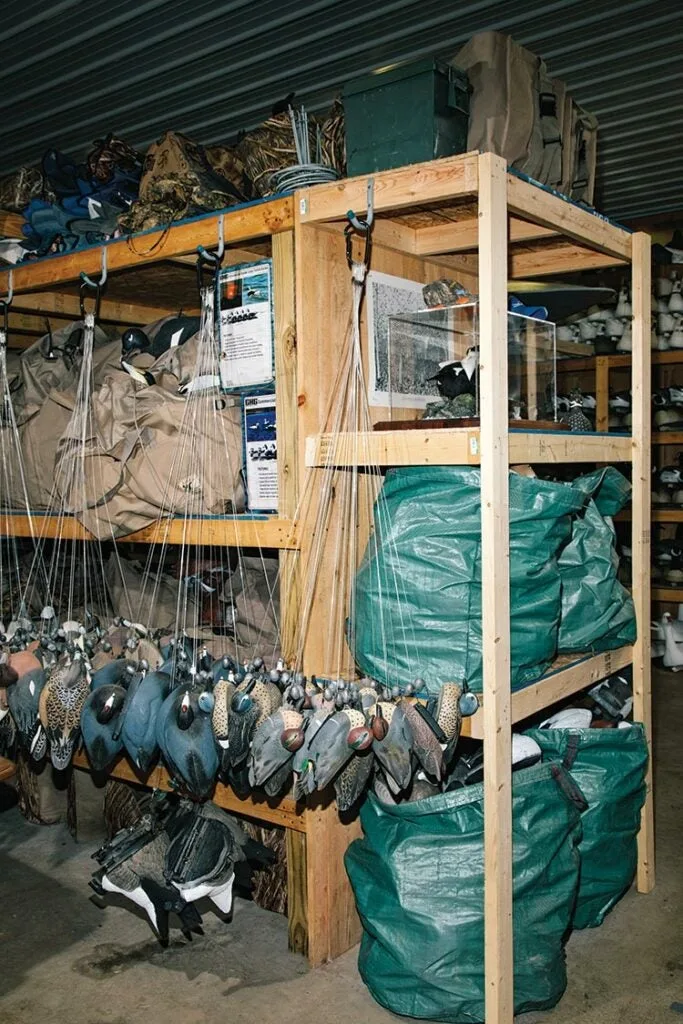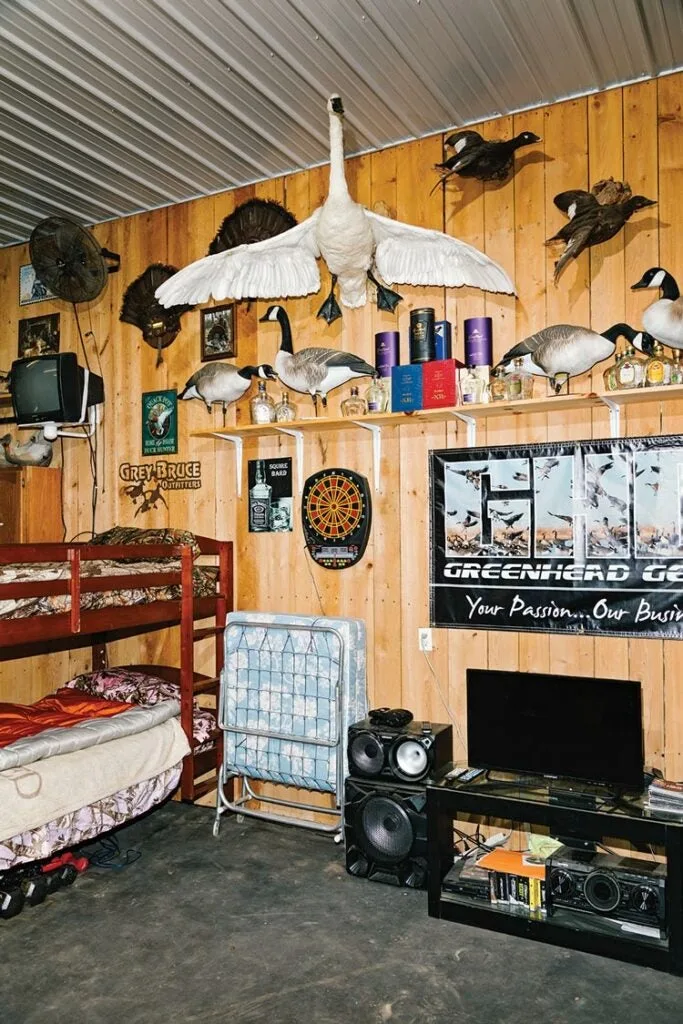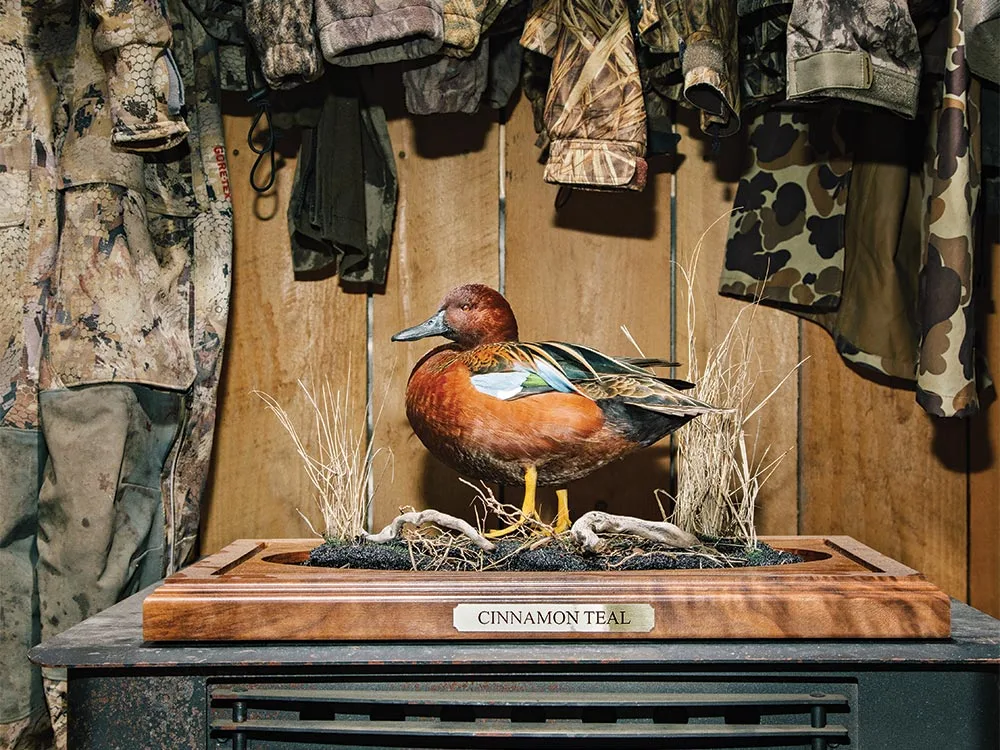Towing sleds loaded heavy with decoys and guns, we humped a quarter mile through a jungle of phragmites and cattails, 10-foot-tall reeds bent under the weight of fresh snow. Sweating and stripped down to our base layers on a single-digit day, we punched out of the tangle and into a pool of open water on the south end of Great Salt Lake.
“Listen,” said Brett Bernardo, a Utah home builder and serious duck hunter, who guided us to this spot. Just beyond the water, we could hear the chatter of teal. Hundreds and hundreds of teal.
After a series of delayed and rerouted flights, my friend Mike Bard and I had finally reached the marsh from New York State. Our mission: one cinnamon teal. After more than 20 years of waterfowl hunting, Bard was one bird away from completing the North American Waterfowl Slam, having hunted and shot every legal duck, goose, swan, and crane on the continent, but for this.

Nice and neat: Bard’s waterfowl gear is meticulously organized. Andrew Hetherington
We rushed to throw out two dozen decoys, and as the last few hit the water, a flock of teal got up 80 yards away. If there were two ducks, there were a thousand. “Get in the reeds,” said Tony Smith, a friend of Bard’s who helped organize the hunt. “Get in the reeds!”
Twenty teal skirted the decoys as we fumbled to load our guns. Then a group of 40 cut in closer. At first, it seemed impossible to pick out the cinnamons from the greenwings, but by the second pass the birds were becoming easier to tell apart. The cinnamons were slightly larger and darker than their green-winged cousins. But for every 10 or 12 greenwings, there was only one cinnamon—at best.

Still life: Taxidermy from past hunts decorates the walls inside the barn. Andrew Hetherington
“Cinnamon, cinnamon,” said Bard. He shot, but the birds kept moving. At the sound of the gunshot, a mass of a thousand-plus birds got up and spun over the reeds 80 yards to the west.
“Left,” said Smith. “On the left.”
The birds swung toward us, then away, behind us, and split into small flocks before 200-plus teal cut in—some at 10 yards, some at 40—darting above the dekes, a flurry of dark silhouettes against the morning sky, with a handful, just a few, a little bigger than the rest. Bard waited for his shot, and the rest of us waited for him.

In the books: Bard logs very detailed records of his waterfowl hunts. Andrew Hetherington
46 Down, One to Go
Unlike with sheep or turkeys, there’s no official list or organizing body that keeps track of the North American Waterfowl Slam. It’s an unofficial collection of 41 to 47 bird species and subspecies. Some hunters count color-phase birds, like the blue variety of lesser snow geese; others don’t. Bard is one of the hunters who counts the color phase, and all that’s keeping him from reaching No. 47 is a cinnamon teal. The quest has taken him all over the continent—from the Bering Sea in Alaska, where he shot a harlequin from a rubber dinghy (after which he fell into the water), to a Florida storm-water treatment pond, where he checked off a mottled duck, to Newfoundland’s Fogo Islands, where he dropped a borealis eider, a subspecies of the common eider.
**See Bard’s Hit List here
.**
A guide himself on New York’s Finger Lakes, Bard killed most of these birds on D.I.Y. hunts in the Atlantic Flyway or on freelance road trips around the upper Midwest. Bard is married and has four kids and a real job, but for the last 15 years he’s spent every second of his spare time studying, scouting, and shooting this continent’s great laundry list of waterfowl. He killed his first bird in 1993, but hunting didn’t become so all-consuming until 2001, when he got out of the Army, graduated from college, and, for the first time since high school, had free time on his hands. He became a pro staffer with Avery and Greenhead Gear and soon had to build a barn to store his 7,500-plus decoys.
Part of the appeal of hunting, he told me, is the camaraderie in a duck blind. He has a team of guys he regularly hunts with, who each bring something special to the table—a boat mechanic, a concealment nut, a buddy who can knock on a door and always get permission to hunt the field out back. “It’s like a platoon, or a squad,” Bard said. “Everyone has a role. I missed that when I left the Army, and I found it again waterfowling.” Completing the slam didn’t really become a priority until after his first trip to Alaska in 2009, when he realized how close he was. That’s when the quest became a compulsion.

Big bird: A tundra swan killed in North Dakota dwarfs the other mounts. Andrew Hetherington
“Honestly, this obsession has become a huge distraction,” he said. “I’ll spend hours on Google Earth because I saw something really ducky on TV and I need to figure that out. A day doesn’t go by that I’m not planning a hunt or fixing something or building something waterfowl related.” He laughed awkwardly. “I struggle with balance.”
For the cinnamon teal, it was important to Bard, too, to complete the slam in the United States. Most outfitted cinnamon teal hunts happen in Mexico, but Bard had a contact in Utah—Smith, a well-known and accomplished Salt Lake duck hunter who Bard had met online and spoken to over the phone a few times. Since Smith specializes in divers, he reached out to a friend, Bernardo, who’s a teal fanatic. Once Smith and Bernardo were on board to help Bard complete his slam, Bard spent the better part of two years planning his trip to Utah.
**Read Next: Travel Tips for Completing the North American Waterfowl Slam
**
Cinnamon on Salt
More than 200 teal were in our teeth, buzzing in from all sides. Some of the ducks landed in the decoys. Others broke out over the reeds. Some rocketed straight up into the clouds. Bard shouldered his gun, swung, and shot. Teal spun away from the decoys in every direction, then, almost as if it happened in slow motion, a single cinnamon drake tumbled to the water.
“I got him,” Bard yelled. “I got him! I got him!”

Last but not least: Bard’s cinnamon teal that completed the slam. Andrew Hetherington
His arms were shaking, and he started to laugh as he tripped out from the reeds and into the open pool. There were shouts and high fives—a celebration in the middle of the marsh with ducks still flying overhead. Bard cradled his first cinnamon teal in one arm.
“That completes it for you?” Bernardo asked.
“That does,” Bard said. “Thanks so much, man.”
I asked Bard: “How do you feel?”
“I’m speechless,” he said. “I don’t know.” Then he laughed, and kissed the duck’s head. The bill on the cinnamon drake was busted from pellets. Bard had made a great shot—but not ideal if you want to mount the bird for the wall. Which he did.
“Don’t worry,” Smith said. “We’re not done yet.”
We hunkered back into the reeds. Five minutes later, the teal were back. Cinnamons bombed into the decoys, zipping into our spread. Shotguns blazed. Birds fell. In less than an hour, we had killed a four-man limit—10 of which were plumed-out, late-season drake cinnamons. It was the kind of action waterfowl hunters dream of, and the perfect way to conclude a veteran hunter’s quest to complete the North American Waterfowl Slam.
“You might have to take up deer hunting now,” I joked.
“Nah,” Bard said. “I think I’m close to shooting a bird in all 50 states.”






